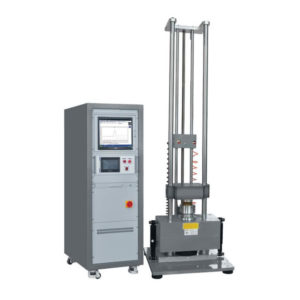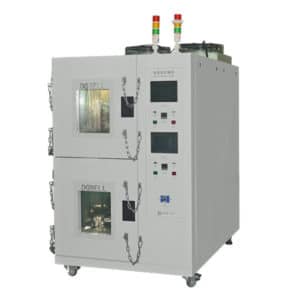Lithium ion battery, as well as the overall sample consisting of non user replaceable battery/lithium ion battery and its electronic products. For non user replaceable batteries, they should be installed in electronic products as a whole sample for standard lithium ion battery environmental safety test; For non user replaceable lithium-ion batteries, they can be placed in electronic products as a whole sample, or they can be taken out separately for standard environmental safety test of lithium-ion batteries. It is recommended that they be preferred as a whole sample for testing. As air leakage, smoke, fire and even explosion may occur during the test, necessary protective measures must be taken, such as placing the sample in a ventilation device with explosion-proof function.
1.Low Air Pressure
Test purpose: The low pressure test is used to simulate the impact of low pressure conditions on the safety of lithium ion batteries during air transportation. After the test, the samples shall be free from fire, explosion and liquid leakage. Instrument and equipment: such as altitude simulation test chamber, vacuum chamber (or low air pressure test chamber).
2.Thermal cycle
Test purpose: The temperature cycling test of lithium ion battery is used to simulate the safety of lithium ion battery when it is repeatedly exposed to low temperature and high temperature during transportation or storage. The test is conducted with rapid and extreme temperature changes. After the test, the sample shall be free from fire, explosion and liquid leakage. Instrument and equipment: such as Thermal cycling test chamber.
3.Vibration
Test purpose: The vibration during the simulated transportation and carrying process of this test shall not lead to safety problems such as liquid leakage, fire and explosion of lithium ion battery. Instruments and equipment; Such as vibration test bench.
Precautions: The following points shall be paid attention to in the lithium ion battery vibration test:
1) The sample shall be fixed in such a way that the vibration signal can be accurately transmitted to the sample without deformation;
2) Each sample shall be subjected to vibration tests in different directions for several times in succession;
3) As for the test direction, the shape of lithium ion battery may be irregular. Three mutually perpendicular directions need to be tested. In addition, it should be noted that after the vibration test of the lithium ion battery, a discharge and charging cycle is also required (it is recommended that a special fixture should be used during the vibration to ensure that the vibration process does not occur such phenomena as sample displacement leading to G value change).
4.Acceleration impact
Test purpose: Lithium ion battery acceleration impact test is to simulate the safety problems such as fire, explosion or liquid leakage when lithium ion battery encounters acceleration impact during carrying or transportation. Instrument and equipment: such as acceleration impact test bench.
Precautions: The following points should be paid attention to in the acceleration impact test of lithium ion battery:
1) The acceleration impact test of lithium ion battery is similar to the vibration test of lithium ion battery. Attention should be paid to the fixing method of samples, multiple tests of each sample, and the test direction.
2) The precautions for peak acceleration of lithium ion battery acceleration impact test are the same as those for battery acceleration impact test.
3) In addition, it should be noted that a discharge charging cycle is required after the acceleration test of lithium ion battery.
5.Drop
Drop the two end faces of the cylindrical and button type lithium ion batteries once respectively, and drop the cylindrical surface twice, and conduct four drop tests in total; Drop each side of the square type lithium ion battery once, and conduct six tests in total; The drop test with equipment shall be conducted for non user replaceable battery/lithium ion battery, and each side of the equipment shall drop once. The sample shall be free from fire, explosion and liquid leakage.
Test purpose: The accidental drop (such as falling from the bench, desk top and hands) during the simulated transportation, carrying and use of this test shall not lead to safety problems such as liquid leakage, fire and explosion of the lithium ion battery. This test simulates a reasonable and predictable accidental fall, without considering the safety problems caused by artificial, intentional, unreasonable and unpredictable falls. Instrument and equipment: such as Battery Drop Tester
Precautions: The following points should be noted in the drop test of lithium ion battery:
1) Each sample needs to withstand the drop test in different directions for several times in succession;
2) Necessary measures shall be taken to ensure the accuracy of the test direction and ensure that such measures shall not affect the free fall movement;
3) The drop test conditions for lithium ion batteries also take into account the accidental drop during actual use, so a 1.5m drop test is required for some lithium ion batteries; In addition, it should be noted that a discharge and charging cycle is required for the lithium ion battery to drop.
6.High temperature test
The sample shall be safe enough for use at high temperature. The following high temperature use test is used to check whether it is qualified: put the fully charged sample in the high temperature test chamber, and the temperature in the test chamber is set as the upper limit temperature of charge and discharge of lithium ion battery, the upper limit temperature of charge and discharge of battery and the maximum value of 80 ℃ specified by the manufacturer. After the surface temperature of the sample is stabilized, keep it for 7h.
The sample shall meet one of the following requirements:
1) Cut off the circuit without fire, explosion and liquid leakage;
2) If the circuit is not cut off, the charging and discharging method during the high temperature test shall continue to conduct a discharge charging cycle, and the sample shall be free from smoke,flame and liquid leakage.
Test purpose: This test simulates the safety of lithium ion battery when it is used in high temperature environment. For example, leave the mobile phone in standby or vehicle charging state in the car exposed to the sun for a long time. Instrument and equipment: such as high temperature test chamber.
Precautions: The following points shall be paid attention to in the high temperature test of lithium ion battery:
1) The high temperature holding time shall be 7h, and the timing shall be started after the sample surface temperature is balanced. If the time for conducting a discharge and charging cycle is more than 7h, The high temperature test time can be extended to the end of this charging and discharging cycle
2) The test temperature is the upper limit temperature of lithium ion battery charging (such as 40 ℃) and upper limit temperature of discharging (such as 55 ℃). The upper limit temperature of battery charging (such as 45 ℃) and upper limit temperature of discharging (For example, the maximum value between 60 ℃ and 80 ℃, generally: the upper limit temperature of lithium ion battery charging ≤ the upper limit temperature of battery charging<80 ℃, and the upper limit temperature of lithium ion battery discharging ≤ the upper limit temperature of battery discharging<80 ℃, so the test temperature is generally selected as 80 ℃.
3) Since the air flow in the test chamber will accelerate the heat transfer, which will cause the heat loss on the battery surface during the charging and discharging process, Therefore, it may be necessary to reduce the wind speed and other ways to minimize the impact on the sample.






